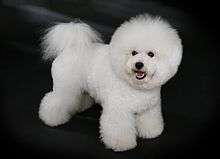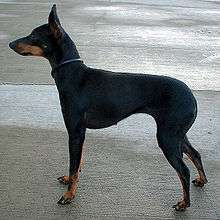Toy dog

Toy dog traditionally refers to a very small dog or a grouping of small and very small breeds of dog. A toy dog may be of any of various dog types. Types of dogs referred to as toy dogs may include Spaniels, Pinschers and Terriers that have been bred down in size. Not all toy dogs are lapdogs, although that is an important and ancient type of toy dog. The very smallest toy dogs are sometimes called teacup size, although no major dog registry recognizes that term.
Small dogs




Dogs referred to as toy or teacup dogs, are dogs found in the Toy Group of breed registries, may be of the very ancient lapdog type, or they may be small versions of hunting dogs or working dogs, bred down in size for a particular kind of work or to create a pet of convenient size. In the past, very small dogs not used for hunting were kept as symbols of affluence, as watchdogs, and for the health function of attracting fleas away from their owners.[1]
Breeds
Most major dog clubs in the English-speaking world have a toy group, under one exact name or another, in which they place breeds of dog that the kennel club categorises as toy, based on size and tradition. The Kennel Club (UK), the Canadian Kennel Club, the American Kennel Club, the Australian National Kennel Council, and the New Zealand Kennel Club all have a group named "Toy", all though they may not all categorise the same breeds in this category. The United States has a second major kennel club, the United Kennel Club (UKC, originally formed for hunting and working breeds, though general today), and it does not recognize such a group; instead, small dogs are placed with larger dogs of their type, or into a UKC's "Companion Dog" group.[2] As of September 2008, the American Kennel Club began debating whether or not to change the name of their "Toy" group to "Companion", in order to emphasise that dogs are not playthings, but the name change was resisted by traditionalists.[3]
The Fédération Cynologique Internationale has established common nomenclature to ensure that pedigrees are mutually recognized in all 84 member countries. The following breed sections are recognized by the Fédération Cynologique Internationale in Group 9, Toy and Companion.[4]
- Section 1: Bichons and related breeds
- Section 2: Poodle
- Section 3: Small Belgian dogs
- Section 4: Hairless dogs
- Section 5: Tibetan breeds
- Section 6: Chihuahua
- Section 7: English Toy Spaniels
- Section 8: Japanese Chin and Pekingese
- Section 9: Continental Toy Spaniel
- Section 10: Kromfohrländer
- Section 11: Small Molossian type dogs
Not including the colour and size varieties, breeds categorized by Fédération Cynologique Internationale members as "Companion and Toy" are listed here. Those with flags are also recognized by the non-member countries indicated by the flag.
- Mi-Ki

- Maltese



- Havanese



- Bichon Frise

- Bolognese (Bolognese)

- Coton de Tulear

- Löwchen (Löwchen, Little Lion Dog)
- Poodle (All three sizes are in the Fédération Cynologique Internationale Companion and Toy group)
- Griffon Bruxellois (Brussels Griffon)



- Petit Brabançon (Small Brabant Griffon)
- Chinese Crested Dog



- Lhasa Apso
- Shih Tzu

- Tibetan Spaniel
- Tibetan Terrier
- Chihuahua

- Cavalier King Charles Spaniel



- King Charles Spaniel
- Pekingese



- Japanese Chin (Chin)


- Phalène (Epagneul nain Continental, Continental Toy Spaniel)
- Papillon



- Kromfohrländer
- French Bulldog (Bouledogue français)
- Pug



- Boston Terrier
- Russkiy Toy
- Shiba Inu
Registries within individual Fédération Cynologique Internationale members, such as the Australian National Kennel Council, may use slightly different nomenclature, depending on the country. Non-member countries use other terminology, but the term toy is only used to group dogs for show purposes.
The Kennel Club (UK) places breeds marked ![]() in the Toy Group:[5]
in the Toy Group:[5]
The Canadian Kennel Club recognizes breeds marked ![]() in Group 5, Toys:[6]
in Group 5, Toys:[6]
The American Kennel Club places breeds marked ![]() in the Toy Group:[7]
in the Toy Group:[7]
In addition, these national organizations also recognize the following breeds in their toy groups:
- Affenpinscher





- Australian Silky Terrier



- Chihuahua (Long Coat)




- Chihuahua (Smooth Coat)



- Chihuahua (Short Coat)

- English Toy Terrier (Black & Tan)




- King Charles Spaniel

- Italian Greyhound





- Japanese Chin

- King Charles Spaniel


- Löwchen



- Manchester Terrier

- Mi-Ki

- Miniature Pinscher





- Pomeranian





- Poodle


- Australian Silky Terrier


- Toy Fox Terrier

- Toy Manchester Terrier


- Yorkshire Terrier





- Mexican Hairless Dog

The major national kennel club for each country will have its own list of breeds that it recognizes as Toy. In addition, some new or newly documented rare breeds may be awaiting approval by a given kennel club. Some new breeds may currently be recognized only by their breed clubs. Some rare new breeds have been given breed names, but may only be available from the breeder or breeders who are developing the breed, and may not yet be recognized by any kennel club.
In addition to the major registries, there are a plethora of sporting clubs, breed clubs, and internet-based breed registries and businesses in which dogs may be registered in whatever way the owner or seller wishes.[8]
Teacup dogs
No major or reputable dog registry recognizes the term "teacup" dog, thus the toy/teacup boundary remains fuzzy. The standard size for a toy dog ranges from 4 to 7 pounds; anything smaller than the standard size of a toy dog may be a runt of a litter. No official size defines a teacup dog, but unofficially a teacup dog is considered to be a dog that is 17 inches or less and weighs 4 lbs or less at the age of 12 months. There are no specific teacup dog breeds, but popular types for breeding teacup dogs include: Shih Tzu, Chihuahua, Yorkshire Terrier, Poodle, Pug, Maltese, Pomeranian, and Silky Terrier, among others.
Most recognized breeders do not breed anything smaller than 4 pounds and, therefore, most do not breed "teacup" dogs. "Teacup" dogs breed down and have a lifespan of 12–14 years.
Because teacup dogs are bred to be unnaturally miniature sized, they are prone to many serious health issues. Teacup dogs often suffer from hypoglycemia (low blood-sugar), which can cause seizures and even death if not carefully monitored. Teacup dogs often need to be fed several times a day or more to avoid low blood-sugar levels. They also commonly suffer from liver shunts, hydrocephalus (water on the brain), heart problems, and respiratory problems.[9] Teacup puppies also tend to have incontinence issues due to their extremely small bladder sizes.[10] This is especially prevalent when genetic health testing and other health testing required by breed clubs is not performed.
Teacup dogs are particular en vogue, and because of this breeders can charge extremely high prices for coveted teacup dogs. Some breeders utilize breeding methods harmful to the health of the dogs involved. Teacup dogs are bred by mating two already unusually small dogs of the same breed. Since the mother dog is already so small, there are often birthing complications which threaten the mother and puppies. Some breeders purposely induce stunted growth through malnutrition and even starvation in some cases.
Since the teacup dog is not an official or regulated breed category, it's very easy for breeders to mislead uninformed buyers. Breeders can easily market a regular dog as a teacup dog simply by lying about the puppy's age. Teacup dogs are also often runts of a litter, which means that while they may be unusually small puppies, there is no guarantee they will not grow to become regular-sized dogs for their breed.[11]
What makes a toy breed
Size

The diminutive Yorkshire Terrier is in the Toy Group of many breed registries. The Australian Terrier is one of the smallest terriers, but is usually listed in the Terrier group. In some registries, however, the Yorkshire Terrier is listed in the Companion Dog group. Some registries do not recognize a Toy category.
The use of the word "toy" to describe small dogs that belong to a toy breed is redundant and also incorrect, suggesting that the breed comes in different sizes—there is no such thing, for example, as a "toy Chihuahua"; all Chihuahuas are categorized in the Toy Group. Some breeds do come in different sizes, such as Poodles, which come in standard, miniature, and toy varieties. The size varieties may all be placed within one group, as with the German Spitz breed under the Fédération Cynologique Internationale rules, or the smallest varieties of a breed may be placed as a separate breed in the Toy Group or some other group. The exact categorization varies between registries and countries. The pug is probably the largest of the toy dog group, weighing an average of up to 18 pounds.
The very smallest toy dogs are sometimes called "teacup" size, although no major dog registry recognizes that term. Most dogs labeled "teacup" dogs are simply undersized dogs (usually runts). The name is often applied to small dogs by unscrupulous breeders in order to make more money off of the dog by making it seem special. Dogs bred to be "teacups" often have many health problems associated with them.[12][13]
The Shih Tzu is a toy dog; however, some refer to the Shih Tzu as teacup, toy, toi, pint-size, pocket, imperial, IMP, Chinese imperial dog, CID, mini, miniature or standard. All these references are considered inappropriate and are categorically rejected by the American Shih Tzu Club, Inc. as the National Breed Club maintains there is but one “Shih Tzu” and the ideal weight is 9-16 lbs. (This does not negate the fact that size may vary and those smaller than what is defined as the ideal are not uncommon in litters produced by sires and dams that fall within the ideal weight range.) The use of such descriptive labels is generally regarded as a misleading marketing ploy, as is pitching Shih Tzu to be of "rare color."
Form versus function
Another area of contention is the idea that toy dogs are only companion animals, slow moving, with little need for exercise and with low endurance. Papillons give lie to this; although dainty and small they are quite capable of taking long walks with their owners and often excel at the energetic sport of dog agility. Maltese are another example of very robust daintiness. The United Kennel Club (US), which does not recognize a Toy group, defines Italian Greyhounds as having been bred exclusively as pets; the American Kennel Club states that these dogs were bred as gazehounds, dogs that hunt by sight, and are quite fast and hardy, but they are nevertheless placed in the Toy group.[14]
See also
References
- ↑ Bruce Felton and Mark Fowler (1994). "Fashion and Grooming". The Best, Worst, and Most Unusual. New York: Galahad Books. p. 538. ISBN 0-88365-861-5.
- ↑ United Kennel Club (US) breed groups
- ↑ Toys Are Us? by Stephanie Abraham, AKC Gazette, September 2008, pp 55-56
- ↑ Fédération Cynologique Internationale Group 9
- ↑ The Kennel Club Toy Group
- ↑ Canadian Kennel Club Group 5
- ↑ American Kennel Club Toy Group
- ↑ Dog Breed Registries in North America
- ↑ http://terriblyterrier.com/teacup-dogs/
- ↑ http://www.small-breed-dogs.com/Teacup-Puppies.html
- ↑ http://www.dogbreedidentifier.com/teacup-dogs/
- ↑ Dale, Steve (Feb 13, 2004). "Teacup' Dog Prone To Health Woes". Bangor Daily News. Retrieved 10 February 2014.
- ↑ "Doggone Dog Dander – Not With These Non-Shedders". Retrieved 10 February 2014.
- ↑ Carole Marsh. Bow Wow Missouri Dogs in History Mystery,Legends,Lore,Humor and More. 21.
External links
- Toy Group at DMOZ
- Toy Dog Breeds That Don't Shed
- Types of Small Dogs at Dogalicious.net
- Dogs That Don't shed
- List of Small Dog Breeds

.jpg)